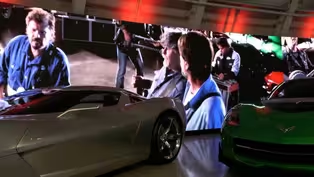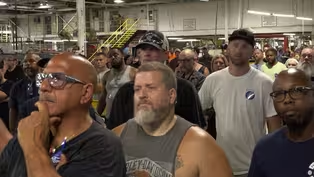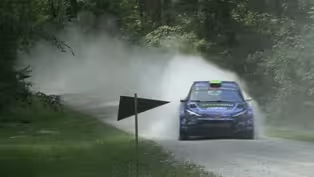
History of Kentucky's South-Central Region
Clip: Season 4 Episode 30 | 3m 28sVideo has Closed Captions
A look at how the region was settled and how it developed.
Kentucky Edition is On the Road this week to Bowling Green and Kentucky's South-Central region. Toby Gibbs looks at the people, places, and events surrounding how the region was settled and developed.
Problems playing video? | Closed Captioning Feedback
Problems playing video? | Closed Captioning Feedback
Kentucky Edition is a local public television program presented by KET

History of Kentucky's South-Central Region
Clip: Season 4 Episode 30 | 3m 28sVideo has Closed Captions
Kentucky Edition is On the Road this week to Bowling Green and Kentucky's South-Central region. Toby Gibbs looks at the people, places, and events surrounding how the region was settled and developed.
Problems playing video? | Closed Captioning Feedback
How to Watch Kentucky Edition
Kentucky Edition is available to stream on pbs.org and the free PBS App, available on iPhone, Apple TV, Android TV, Android smartphones, Amazon Fire TV, Amazon Fire Tablet, Roku, Samsung Smart TV, and Vizio.
Providing Support for PBS.org
Learn Moreabout PBS online sponsorshipKentucky edition goes on the road tomorrow to Bowling Green, but will go beyond Warren County.
South central Kentucky has a long history.
Our Toby Gibbs looks at the people, places and events surrounding how the region was settled and how it developed.
South central Kentucky, including Warren County and the surrounding counties of Allen, Baron Butler, Edmonson, Logan and Simpson, was home to many Native American villages, with the Shawnee tribe prominent in the region.
The first Europeans in the area were so-called Long Hunters, whose hunting expeditions in the frontier could last for months at a time.
They arrived in the 1770s.
Among the early settlements Logan County's malting station, founded on the Red River in 1780, and McFadden's station on the barren River in present day Warren County, founded in 1785.
Many of the early settlers were of Scots-Irish backgrounds.
Fittingly, the barren county seat of Glasgow is named after Glasgow, Scotland.
As for other names, many counties are named after war heroes of the Revolutionary War and War of 1812.
Colonel John Allen, Captain John Simpson, Kentucky militia leader Benjamin Logan, major General Richard Butler, and captain Jack Edmundson.
The best known might be General Joseph Warren, the man who dispatched Paul Revere to warn colonists about approaching British troops.
Warren was a hero of the Battle of Bunker Hill.
Baron County is named for the Barons, a section of Meadowlands that covers the northern third of the county.
The inspiration for the name Bowling Green is in dispute.
Some say it's named after Bowling Green, Virginia, home of some of the early settlers.
Others say it's name for Bowling Green in New York City, where colonists pulled down a statue of King George the Third and used the head to make bullets.
Steamboats on the barren River helped Bowling Green grow, especially after the building of locks and dams made the river easier to navigate.
The Louisville and Nashville Railroad came through the region in 1859, bringing more industry.
There were divided loyalties during the Civil War.
Butler County was considered a Union stronghold, but Bowling Green and Warren County served as provisional capital for Kentucky's Confederate sympathizer years.
Confederates occupied Warren County starting in September of 1861, but Union forces took it.
In February of 1862, as Confederates retreated into Tennessee, agriculture was the mainstay of the early economy, especially tobacco, cattle, hogs, and hay.
Simpson County was recognized as one of the biggest mule markets in the world.
The area has its share of celebrities.
Allen County was home to Emma Guy Cromwell, the first woman elected to statewide office when she became Secretary of State in 1924.
Alice Dunnigan, of Logan County, was the first black woman to serve as a white House reporter.
Governor Louis B Nunn hailed from Barren County, and Andrew Jackson from nearby Tennessee fought a duel in Logan County in 1806, according to the 2020 census.
The seven counties together have 271,000 people, with almost half of those 134,000.
In Warren County for Kentucky edition, I'm Toby Gibbs.
Bowling Green Home to America's Sports Car
Video has Closed Captions
Clip: S4 Ep30 | 3m 17s | The National Corvette Museum's new CEO talks about what the attraction means for the region. (3m 17s)
Ford Investing Nearly $2 Billion to Make EVs in Kentucky
Video has Closed Captions
Clip: S4 Ep30 | 2m 15s | Ford says it will invest nearly $2 billion to retool a Kentucky plant to produce electric vehicles. (2m 15s)
GOP Senate Candidates Attend Lincoln Day Dinner
Video has Closed Captions
Clip: S4 Ep30 | 5m 34s | GOP Senate candidates take their campaigns to the Lincoln Day Dinner. (5m 34s)
Motorsports Rally Held in Eastern Kentucky
Video has Closed Captions
Clip: S4 Ep30 | 3m 3s | Supporters of the event say Eastern Kentucky is uniquely suited for this kind of race. (3m 3s)
Providing Support for PBS.org
Learn Moreabout PBS online sponsorship
- News and Public Affairs

Top journalists deliver compelling original analysis of the hour's headlines.

- News and Public Affairs

FRONTLINE is investigative journalism that questions, explains and changes our world.












Support for PBS provided by:
Kentucky Edition is a local public television program presented by KET



